Rossby Waves in Total Ozone over the Arctic in 2000–2021
Abstract
:1. Introduction
2. Data and Analysis Method
3. Results
3.1. Total Ozone Zonal Distribution
3.2. Daily Variations
3.3. Interannual Variations
3.4. Linear Trends
4. Discussion
5. Conclusions
Author Contributions
Funding
Informed Consent Statement
Acknowledgments
Conflicts of Interest
References
- Matsuno, T. Vertical propagation of stationary planetary waves in the winter Northern Hemisphere. J. Atmos. Sci. 1970, 27, 871–883. [Google Scholar] [CrossRef] [Green Version]
- Domeisen, D.I.V.; Butler, A.H. Stratospheric drivers of extreme events at the Earth’s surface. Commun. Earth Environ. 2020, 1, 59. [Google Scholar] [CrossRef]
- Manney, G.L.; Livesey, N.J.; Santee, M.L.; Froidevaux, L.; Lambert, A.; Lawrence, Z.D.; Millán, L.F.; Neu, J.L.; Read, W.G.; Michael, J.; et al. Record-low Arctic stratospheric ozone in 2020: MLS observations of chemical processes and comparisons with previous extreme winters. Geophys. Res. Lett. 2020, 47, e2020GL089063. [Google Scholar] [CrossRef]
- Weber, M.; Dikty, S.; Burrows, J.P.; Garny, H.; Dameris, M.; Kubin, A.; Abalichin, J.; Langematz, U. The Brewer-Dobson circulation and total ozone from seasonal to decadal time scales. Atmos. Chem. Phys. 2011, 11, 11221–11235. [Google Scholar] [CrossRef] [Green Version]
- Butchart, N. The Brewer-Dobson circulation. Rev. Geophys. 2014, 52, 157–184. [Google Scholar] [CrossRef]
- Solomon, S.; Garcia, R.; Rowland, F.; Wuebbles, D. On the depletion of Antarctic ozone. Nature 1986, 321, 755–758. [Google Scholar] [CrossRef] [Green Version]
- Wohltmann, I.; von der Gathen, P.; Lehmann, R.; Maturilli, M.; Deckelmann, H.; Manney, G.L.; Davies, J.; Tarasick, D.; Jepsen, N.; Kivi, R.; et al. Near-complete local reduction of Arctic stratospheric ozone by severe chemical loss in spring 2020. Geophys. Res. Lett. 2020, 47, e2020GL089547. [Google Scholar] [CrossRef]
- Fusco, A.C.; Salby, M.L. Interannual variations of total ozone and their relationship to variations of planetary wave activity. J. Clim. 1999, 12, 1619–1629. [Google Scholar] [CrossRef]
- Charney, J.G.; Drazin, P.G. Propagation of planetary-scale disturbances from the lower into the upper atmosphere. J. Geophys. Res. 1961, 66, 83–109. [Google Scholar] [CrossRef]
- Domeisen, D.I.V.; Martius, O.; Jiménez-Esteve, B. Rossby wave propagation into the Northern Hemisphere stratosphere: The role of zonal phase speed. Geophys. Res. Lett. 2018, 45, 2064–2071. [Google Scholar] [CrossRef] [Green Version]
- Hood, L.L.; Zaff, D.A. Lower stratospheric stationary waves and the longitude dependence of ozone trends in winter. J. Geophys. Res. 1995, 100, 25791–25800. [Google Scholar] [CrossRef]
- Dütsch, H.U. The ozone distribution in the atmosphere. Can. J. Chem. 1974, 52, 1491–1504. [Google Scholar] [CrossRef]
- Alexander, S.P.; Shepherd, M.G. Planetary wave activity in the polar lower stratosphere. Atmos. Chem. Phys. 2010, 10, 707–718. [Google Scholar] [CrossRef] [Green Version]
- Hu, J.; Ren, R.; Xu, H. Occurrence of winter stratospheric sudden warming events and the seasonal timing of spring stratospheric final warming. J. Atmos. Sci. 2014, 71, 2319–2334. [Google Scholar] [CrossRef]
- Baldwin, M.P.; Ayarzagüena, B.; Birner, T.; Butchart, N.; Butler, A.H.; Charlton-Perez, A.J.; Domeisen, D.I.V.; Garfinkel, C.I.; Garny, H.; Gerber, E.P.; et al. Sudden stratospheric warmings. Rev. Geophys. 2021, 59, e2020RG000708. [Google Scholar] [CrossRef]
- Butler, A.H.; Sjoberg, J.P.; Seidel, D.J.; Rosenlof, K.H. A sudden stratospheric warming compendium. Earth Syst. Sci. Data 2017, 9, 63–76. [Google Scholar] [CrossRef] [Green Version]
- Butler, A.H.; Gerber, E.P. Optimizing the definition of a Sudden Stratospheric Warming. J. Clim. 2018, 31, 2337–2344. [Google Scholar] [CrossRef]
- Butler, A.H.; Domeisen, D.I.V. The wave geometry of final stratospheric warming events. Weather Clim. Dyn. 2021, 2, 453–474. [Google Scholar] [CrossRef]
- Dhomse, S.; Weber, M.; Wohltmann, I.; Rex, M.; Burrows, J.P. On the possible causes of recent increases in northern hemispheric total ozone from a statistical analysis of satellite data from 1979 to 2003. Atmos. Chem. Phys. 2006, 6, 1165–1180. [Google Scholar] [CrossRef] [Green Version]
- Levelt, P.F.; Joiner, J.; Tamminen, J.; Veefkind, J.P.; Bhartia, P.K.; Zweers, D.C.S.; Duncan, B.N.; Streets, D.G.; Eskes, H.; van der A, R.; et al. The Ozone Monitoring Instrument: Overview of 14 years in space. Atmos. Chem. Phys. 2018, 18, 5699–5745. [Google Scholar] [CrossRef] [Green Version]
- OMI: NASA Ozone Watch, National Aeronautics and Space Administration, Goddard Space Flight Center, Ozone Monitoring Instrument. Available online: https://ozonewatch.gsfc.nasa.gov/ (accessed on 21 February 2022).
- TOMS: Total Ozone Mapping Spectrometer, Goddard Earth Sciences Data and Information Services Center (GES DISC). Available online: https://disc.gsfc.nasa.gov/datasets/ (accessed on 21 February 2022).
- Bacer, S.; Jomaa, F.; Beaumet, J.; Gallée, H.; Le Bouëdec, E.; Ménégoz, M.; Staquet, C. Impact of climate change on wintertime European atmospheric blocking. Weather Clim. Dyn. 2022, 3, 377–389. [Google Scholar] [CrossRef]
- Haarsma, R.J.; García-Serrano, J.; Prodhomme, C.; Bellprat, O.; Davini, P.; Drijfhout, S. Sensitivity of winter North Atlantic-European climate to resolved atmosphere and ocean dynamics. Sci. Rep. 2019, 9, 13358. [Google Scholar] [CrossRef] [PubMed] [Green Version]
- Hongming, Y.; Yuan, Y.; Guirong, T.; Yucheng, Z. Possible impact of sudden stratospheric warming on the intraseasonal reversal of the temperature over East Asia in winter 2020/21. Atmos. Res. 2022, 268, 106016. [Google Scholar] [CrossRef]
- Lu, Q.; Rao, J.; Liang, Z.; Guo, D.; Luo, J.; Liu, S.; Wang, C.; Wang, T. The sudden stratospheric warming in January 2021. Environ. Res. Lett. 2021, 16, 084029. [Google Scholar] [CrossRef]
- Zhang, Y.; Cai, Z.; Liu, Y. The exceptionally strong and persistent Arctic stratospheric polar vortex in the winter of 2019–2020. Atmos. Ocean. Sci. Lett. 2021, 14, 100035. [Google Scholar] [CrossRef]
- Rhines, P.B. Rossby waves. In Encyclopedia of Atmospheric Sciences; Holton, J.R., Ed.; Academic Press: Cambridge, MA, USA, 2003; pp. 1923–1939. [Google Scholar] [CrossRef]
- Madden, R.A. Large-scale, free Rossby waves in the atmosphere—An update. Tellus A Dyn. Meteorol. Oceanogr. 2007, 59, 571–590. [Google Scholar] [CrossRef]
- Sassi, F.; Garcia, R.R.; Hoppel, K.W. Large-scale Rossby normal modes during some recent Northern Hemisphere winters. J. Atmos. Sci. 2012, 69, 820–839. [Google Scholar] [CrossRef]
- Harvey, V.L.; Hitchman, M.H. A climatology of the Aleutian High. J. Atmos. Sci. 1996, 53, 2088–2102. [Google Scholar] [CrossRef] [Green Version]
- Thompson, D.W.J.; Wallace, J.M. Annular modes in the extratropical circulation. Part I: Month-to-month variability. J. Clim. 2000, 13, 1000–1016. [Google Scholar] [CrossRef]
- AO: Arctic Oscillation Index, NOAA National Weather Service, Climate Prediction Center. Available online: https://www.cpc.ncep.noaa.gov/ (accessed on 25 April 2022).
- McCormack, J.P.; Nathan, T.R.; Cordero, E.C. The effect of zonally asymmetric ozone heating on the Northern Hemisphere winter polar stratosphere. Geophys. Res. Lett. 2011, 38, L03802. [Google Scholar] [CrossRef] [Green Version]
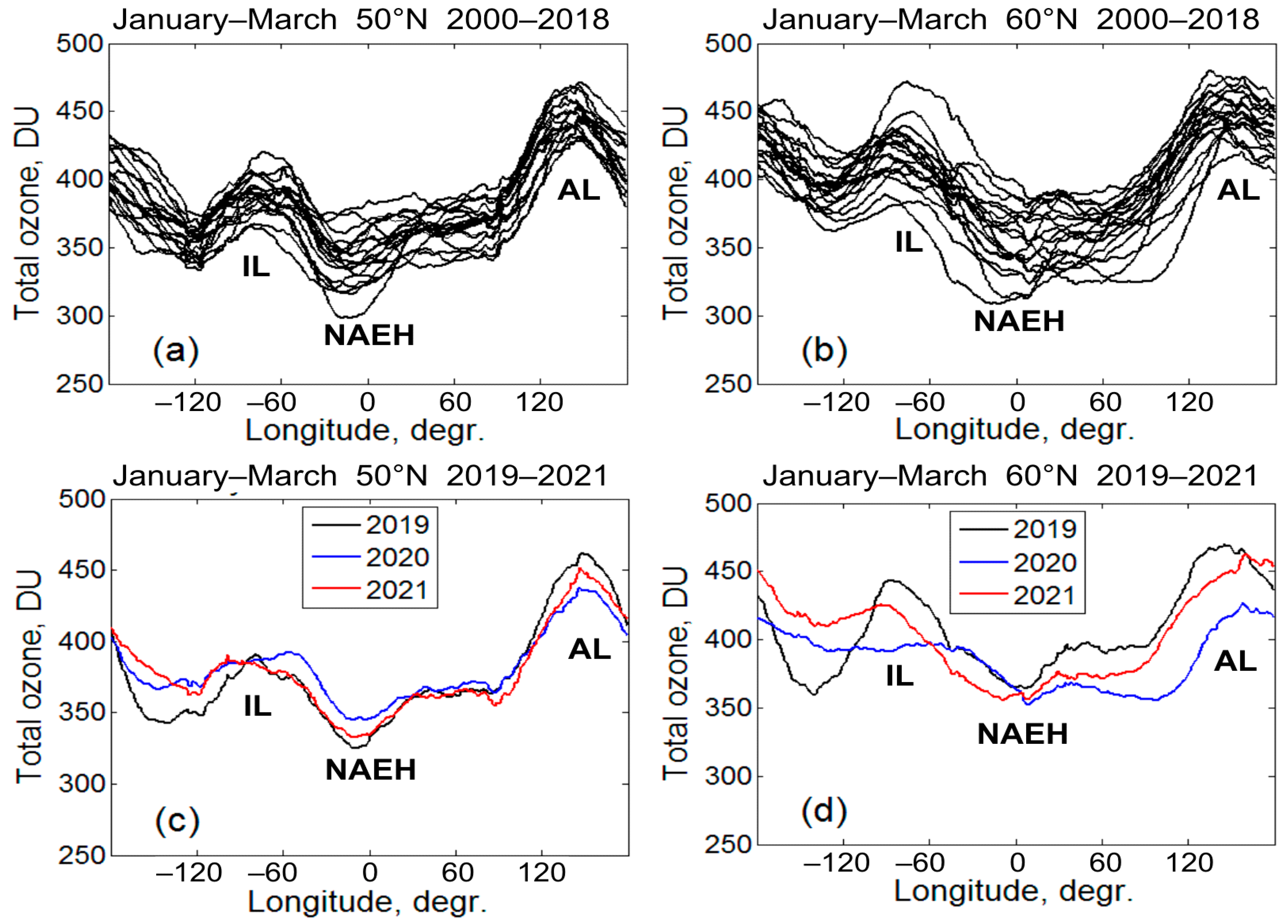
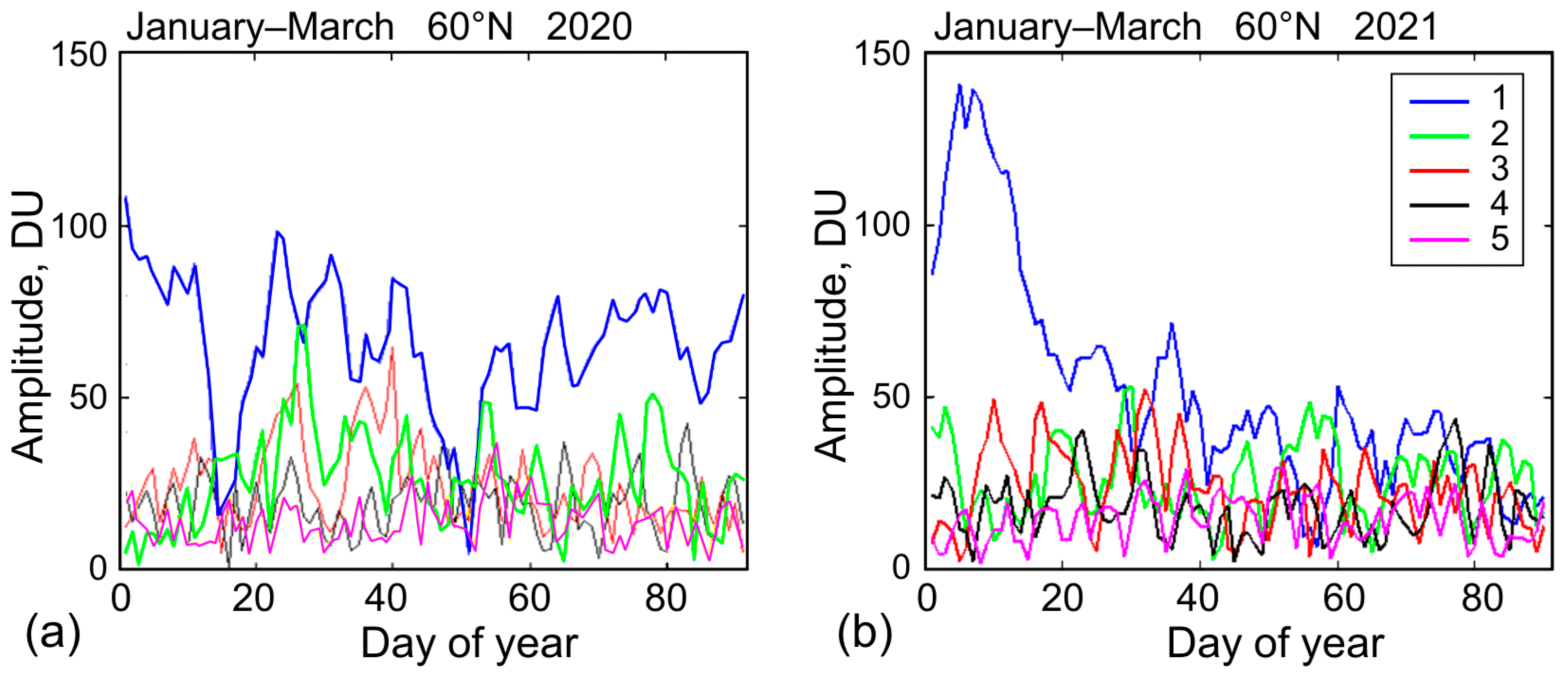
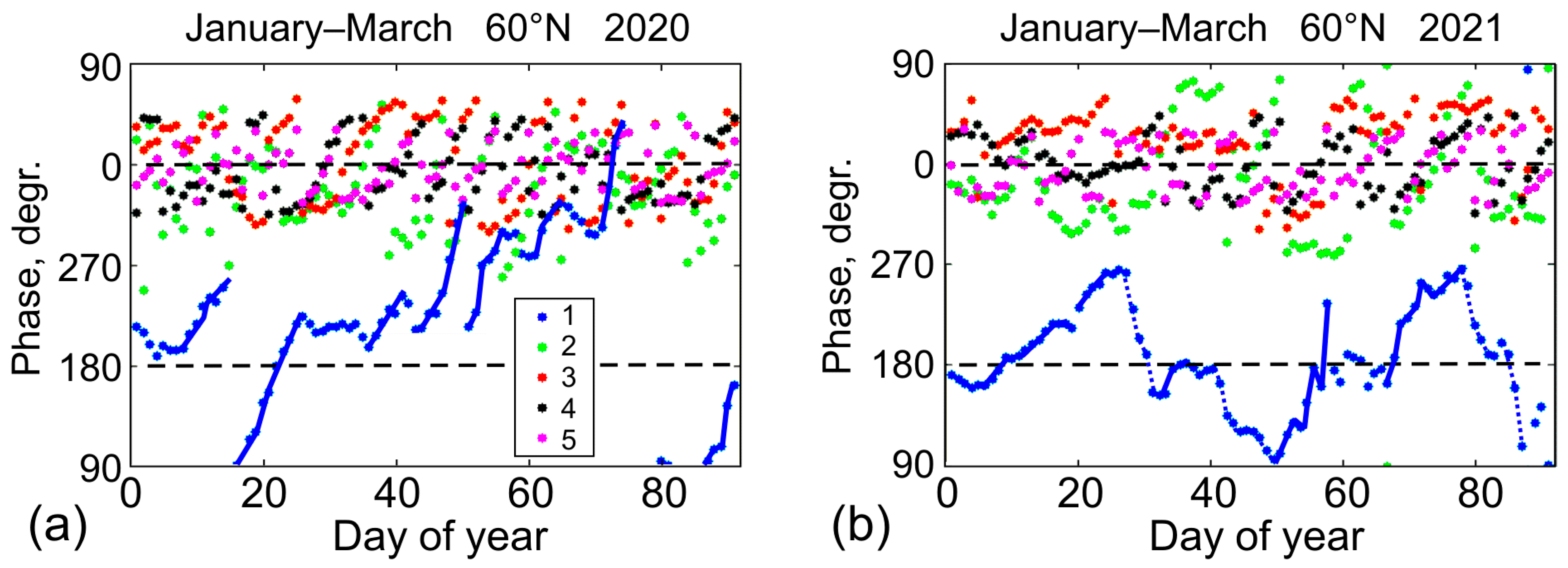

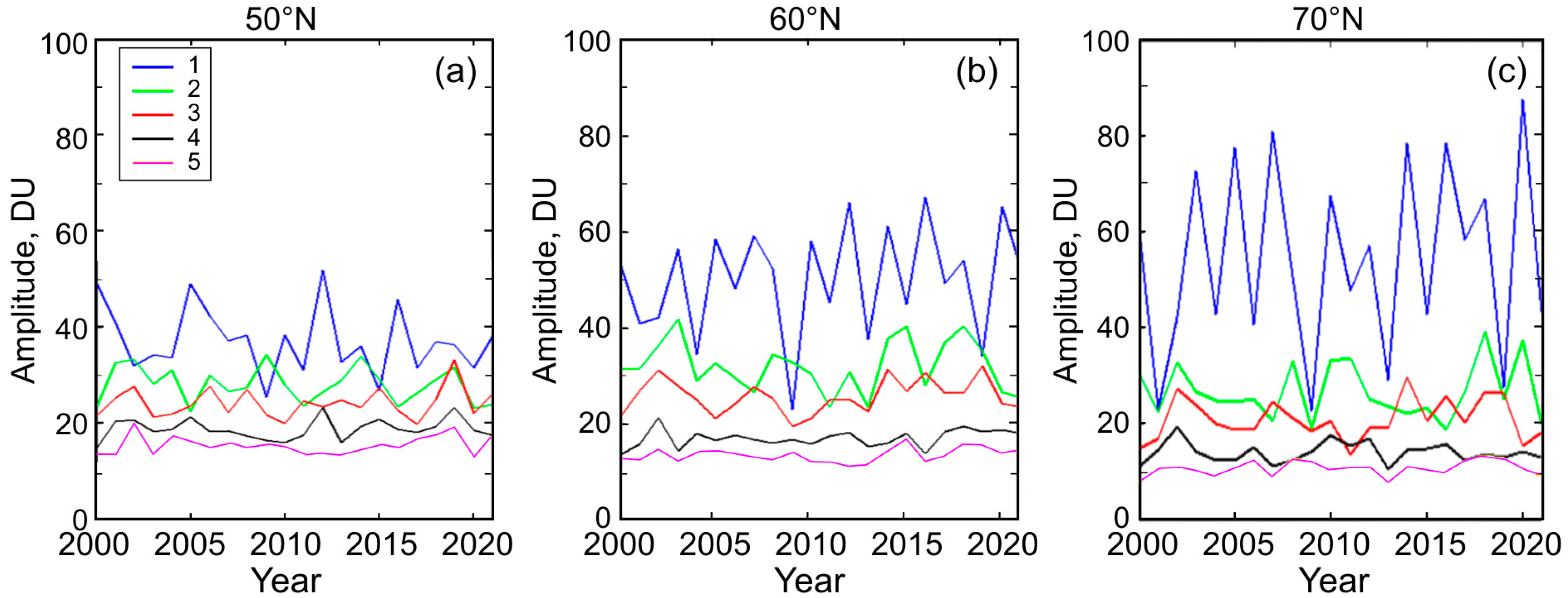

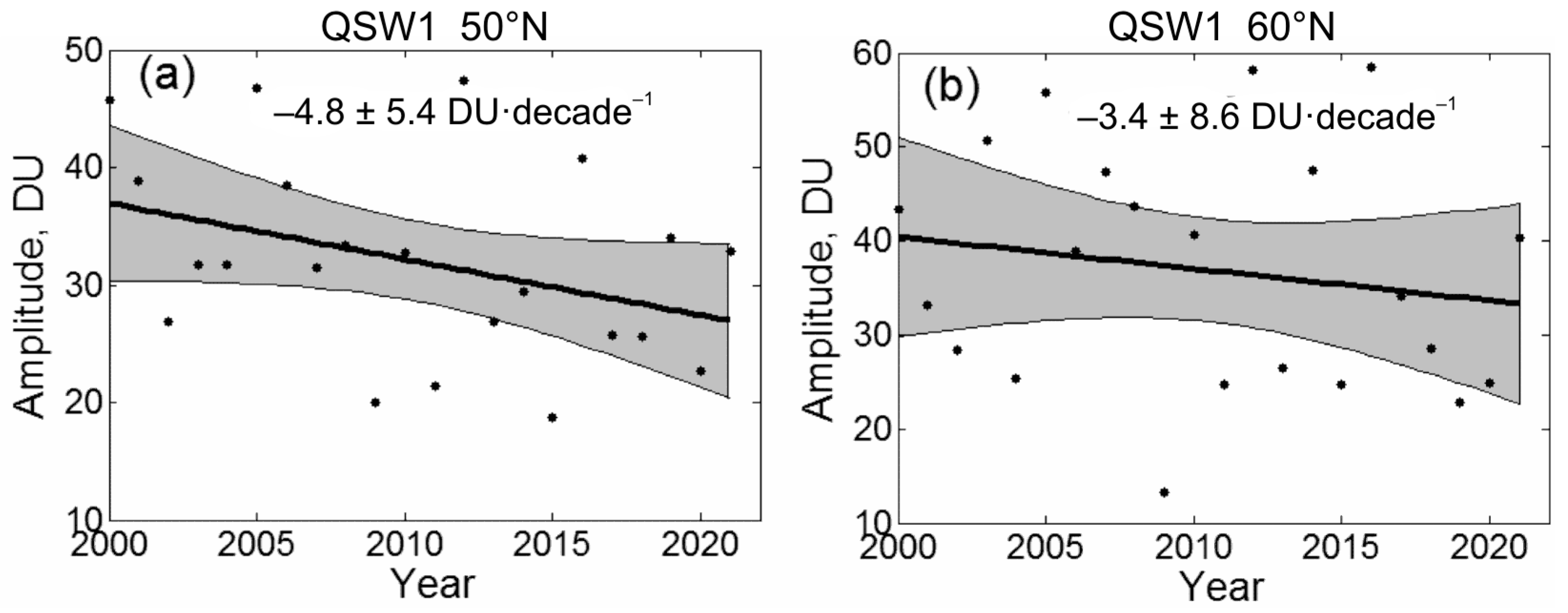
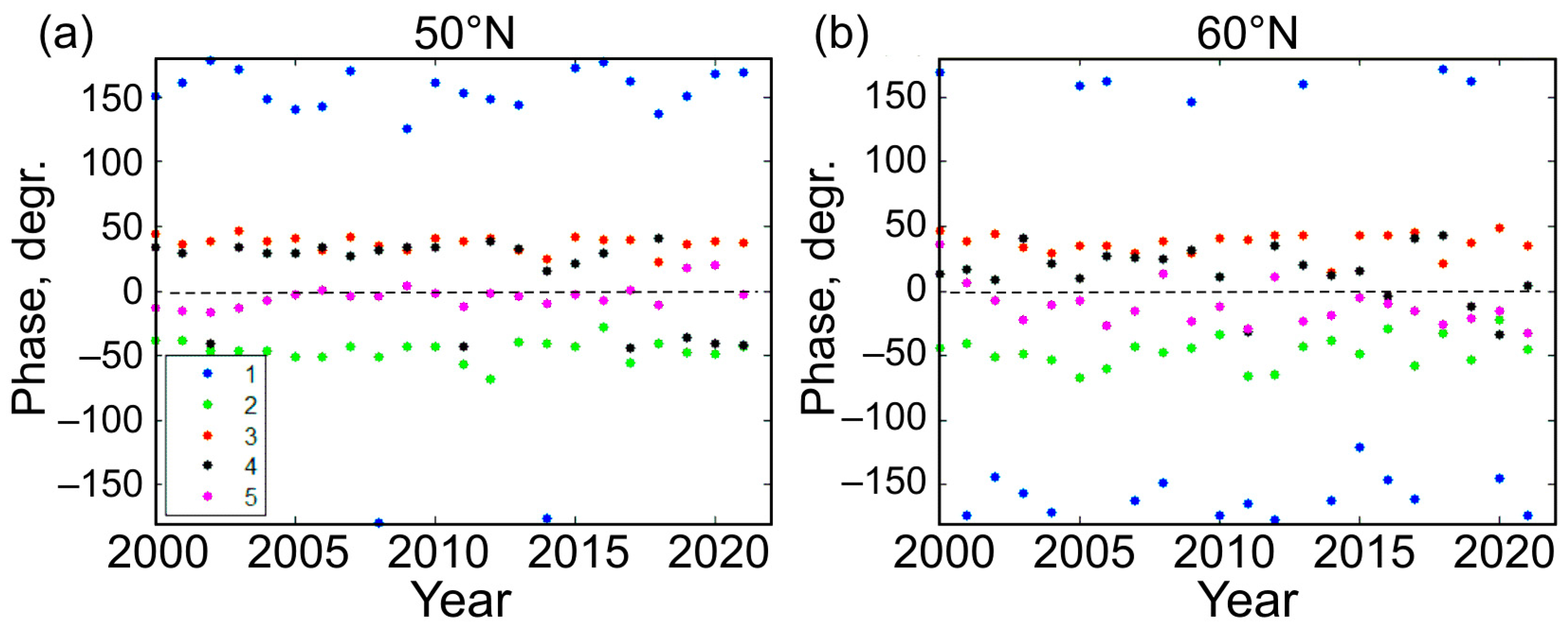
Publisher’s Note: MDPI stays neutral with regard to jurisdictional claims in published maps and institutional affiliations. |
© 2022 by the authors. Licensee MDPI, Basel, Switzerland. This article is an open access article distributed under the terms and conditions of the Creative Commons Attribution (CC BY) license (https://creativecommons.org/licenses/by/4.0/).
Share and Cite
Zhang, C.; Grytsai, A.; Evtushevsky, O.; Milinevsky, G.; Andrienko, Y.; Shulga, V.; Klekociuk, A.; Rapoport, Y.; Han, W. Rossby Waves in Total Ozone over the Arctic in 2000–2021. Remote Sens. 2022, 14, 2192. https://doi.org/10.3390/rs14092192
Zhang C, Grytsai A, Evtushevsky O, Milinevsky G, Andrienko Y, Shulga V, Klekociuk A, Rapoport Y, Han W. Rossby Waves in Total Ozone over the Arctic in 2000–2021. Remote Sensing. 2022; 14(9):2192. https://doi.org/10.3390/rs14092192
Chicago/Turabian StyleZhang, Chenning, Asen Grytsai, Oleksandr Evtushevsky, Gennadi Milinevsky, Yulia Andrienko, Valery Shulga, Andrew Klekociuk, Yuriy Rapoport, and Wei Han. 2022. "Rossby Waves in Total Ozone over the Arctic in 2000–2021" Remote Sensing 14, no. 9: 2192. https://doi.org/10.3390/rs14092192






